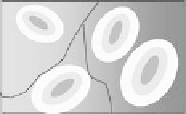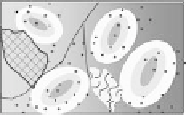Environmental Engineering Reference
In-Depth Information
Gradient
Large Gradient +
Small Gradients +
Linear Features
a
d
Gradient +
Patches
Large Gradient +
Small Gradients +
Linear Features +
Strata
b
e
Gradient +
Small
Gradients
Large Gradient +
Small Gradients +
Linear Features +
Strata + Species
c
f
Fig. 7.1 Spatial heterogeneity as a series of additive processes resulting in additive spatial
patterns to which individual organisms (here represented points) may respond. Some or all of
the different types of spatial heterogeneity may be present in any given landscape
processes and to inform sustainable management techniques that aim to minimize
degradation and alteration of ecosystem dynamics [
3
].
Spatial pattern, or simply spatial structure, refers to a quantifiable attribute of
a spatial context. General definitions of the word pattern include a simple definition
such as a distinctive or regular “form” or “order,” or a feature that is repeated with
some degree of “regularity” [
4
]. Recently, Wagner and Fortin [
5
] defined the more
general term “spatial heterogeneity” as spatially structured variability in a property
of interest. Both exogenous environmental (e.g., edaphic variability, elevation,
climate) and endogenous ecological (e.g., species interactions, pollen, and seed
dispersal) processes generate spatial structure. Each of these two types of spatial
processes can produce spatial pattern in multiple forms and scales (
Fig. 7.1
). The
simplest form of spatial pattern is a simple gradient (
Fig. 7.1a
). Spatial structure can
also be present in the form of patches, linear features, and points and can be
superimposed on a gradient (
Fig. 7.1b-f
). When biological spatial structure is
mostly responding to environmental conditions such as those depicted in
Fig. 7.1
,
the resulting spatial structure is said to have spatial dependency to the environmen-
tal factors. However, when spatial structure emerges as a result of interactions
among ecological processes, the pattern is said to be spatially autocorrelated [
5
].
Spatial patterns and heterogeneity can also be defined using spatial and topological
characteristics. These characteristics can include, but are not limited to, a pattern's
intensity, autocorrelation, degree of clustering, variability, and scale, which itself
includes spatial grain and extent [
6
]. Importantly, a single pattern summarized using
different characteristics can result in different interpretations of the processes behind
that pattern [
7
,
8
].






